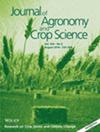The Proportion of Frost-Damaged Leaves: A Simple and Robust Approach for Evaluating Frost Damage in Wheat (Triticum aestivum L.)
Abstract
Frost resistance is a crucial trait in wheat breeding, and accurately assessing the phenotype of frost damage is vital for the genetic improvement of wheat resistance to frost damage. However, the unpredictability of cold wave events and regional variations in frost damage levels complicate the precise evaluation of frost damage. Survival rate and frost damage grade (on a scale of 1 to 5) are commonly used indicators for evaluating frost damage. However, these methods are mainly effective in extreme low-temperature conditions that cause significant wheat mortality or result in severe frost damage ratings above 3. They are not well-suited for the more subtle phenotypic variations associated with common low temperatures, such as those ranging from −10°C to −5°C. In this study, we employed four different phenotyping methods to evaluate the severity of frost damage in a panel of 50 wheat recombinant inbred lines in two distinct environments, and proposed a novel approach to quantify frost damage based on the proportion of frost-damaged leaves (PFD), which proves to be simple and robust for assessing the severity of frost damage in wheat across multiple biological replicates and a spectrum of environmental conditions.

 求助内容:
求助内容: 应助结果提醒方式:
应助结果提醒方式:


